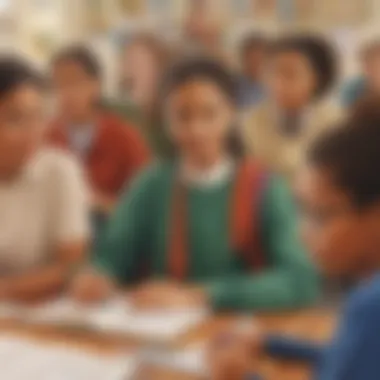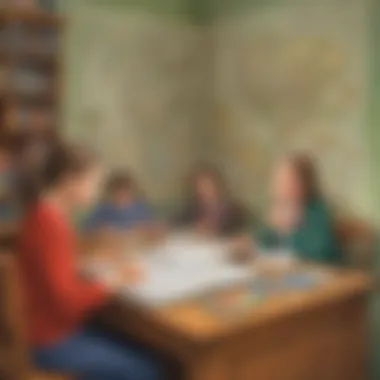Understanding the Hidden Curriculum in Education


Intro
Education is not just about textbooks and tests. There is often a layer of lessons and values that exist outside the formal curriculum. This is known as the hidden curriculum. It encompasses the implicit messages conveyed through school culture, interactions, and expectations. Understanding this phenomenon is key for educators, parents, and students.
The hidden curriculum plays a crucial role in shaping students’ social behaviors, attitudes, and general perceptions of the world. This article aims to shed light on its significance and influence. It will explore how the hidden curriculum affects moral development, social skills, and cultural awareness.
Interactive Learning Games
Learning does not always have to be a serious task. Interactive games can make the process engaging. Many educational games are popular among students, helping them learn while having fun.
Popular Games
Some of the most recognized games include Minecraft: Education Edition, Kahoot!, and Prodigy Math Game. These games have gained traction in both formal and informal educational settings. Their designs encourage exploration and critical thinking.
Description of top educational games
- Minecraft: Education Edition: This game allows students to delve into a virtual world where they can collaborate to build structures and solve problems. It promotes creativity and teamwork.
- Kahoot!: A game-based learning platform, Kahoot! turns classrooms into interactive environments. Teachers create quizzes, and students answer in real time, creating excitement and competition.
- Prodigy Math Game: It combines math practice with adventure. Students solve math problems to progress through the game, making learning a part of the journey.
Benefits of playing educational games for kids' cognitive development
Educational games have mental advantages. They enhance problem-solving skills, encourage logical thinking, and improve attention span. Playing these games can also improve collaboration and communication among peers as they work together to achieve goals.
Game Reviews
In-depth reviews of selected games reveal essential insights.
- Minecraft: Education Edition is praised for its versatility in teaching various subjects. Students learn math, history, and even programming in a playful environment.
- Kahoot! has been shown to increase student engagement and retention of knowledge. The immediate feedback mechanism helps students identify learning gaps.
- Prodigy Math Game maintains a thrilling gaming experience, while ensuring that students practice important math skills aligned with curriculum standards.
Comparison of gameplay and learning outcomes
The gameplay in these educational games often overlaps with learning outcomes. For instance, while Minecraft promotes creativity, it also teaches students to work collaboratively. Similarly, Kahoot! reinforces knowledge retention through repetition and active participation.
Educational Topics
To truly grasp the hidden curriculum, it is important to explore various educational topics. This can span subjects like math, science, or languages. Each subject carries its own unique set of implicit lessons that contributes to a student’s overall learning experience.
Importance of interdisciplinary learning for holistic development
Interdisciplinary learning connects subjects. When students can see the links between different areas of knowledge, they are more likely to understand concepts deeply. This approach fosters critical thinking and adaptability.
Tips and Tricks
Enhancing a child's learning journey can be managed with simple strategies.
- Create a conducive environment: A quiet and organized space promotes focus.
- Use technology wisely: There are many resources available online that can supplement learning.
- Encourage questions: Allowing children to ask questions fosters curiosity and deeper understanding.
Creative DIY Projects
Creativity is key to effective learning. Hands-on activities can make lessons memorable.
Step-by-Step Guides
DIY projects encourage children to explore and create. Giving them detailed instructions can help them follow along and enjoy the process. Projects could include building models or conducting simple science experiments, enriching their understanding through practice.
Craft Ideas
Utilizing simple household items can lead to creative outcomes. Craft projects not only enhance motor skills but also allow children to express their ideas visually. Artistic expression is vital in fostering emotional and social skills that complement academic abilities.
Defining Hidden Curriculum
The hidden curriculum refers to the lessons that are taught outside the formal curriculum in educational settings. This can include implicit values, social norms, and behaviors that students learn indirectly. Understanding this concept is crucial because it lays the foundation for recognizing how schools influence not only academic success but also the personal development of students. By examining the hidden curriculum, educators and caregivers can better appreciate its impact on students' social behaviors and attitudes.


Concept Overview
The hidden curriculum encompasses various elements that go beyond textbooks and formal teaching. It includes:
- Values: Students often adopt the values that their peers and teachers exhibit in the classroom, even if these values are not explicitly taught.
- Cultural Norms: The hidden curriculum also includes cultural expectations that shape how students interact with one another and approach learning.
- Social Skills: Interactions during group projects or lunchtime can teach students essential social skills like cooperation and conflict resolution.
This unspoken set of lessons plays a significant role in how students perceive themselves and their place within society.
Historical Context
Historically, the concept of hidden curriculum has evolved alongside educational theories and practices. In the early 20th century, education focused heavily on content delivery and measurable outcomes. However, as the importance of social aspects of education became evident, scholars and educators started to highlight the significance of non-explicit learning.
Understanding the historical context helps in recognizing how views on education have changed. Today, the hidden curriculum is acknowledged as a vital element in shaping a student’s experience. Those who study education apply this concept to analyze how various factors, such as race and economic background, influence students differently. This examination can lead to more inclusive practices that address inequality in education, thus benefiting all students.
Components of Hidden Curriculum
The hidden curriculum encompasses various components that significantly shape students’ educational experiences. Understanding these components provides insights into the implicit lessons that arise outside the formal curriculum. Recognizing these elements is essential for educators and caregivers. Addressing them can enhance educational strategies, fostering an environment conducive to holistic development. The components reflect broader societal values and norms, influencing students' behavior and attitudes in academic settings and beyond.
Social Norms and Values
Social norms and values form a core part of the hidden curriculum. They dictate how students are expected to interact with one another and adhere to established behaviors. For example, students learn about cooperation, respect, and empathy through informal interactions. These lessons occur during group activities, lunch breaks, and even unspoken classroom dynamics. Recognizing these social norms allows educators to create practices that reinforce positive behaviors. Furthermore, understanding the values imparted through social interactions can help address issues of bullying and exclusion.
Behavioral Expectations
Behavioral expectations often stem from the existing culture students are part of. These expectations inform students about how to behave in different settings. For instance, punctuality is a norm in many educational environments. Students learn that arriving on time is valued and shows respect for others' time. Disciplinary measures also convey behavioral expectations. Rules around noise in the classroom, pass usage, and respect for authority are fundamental. Educators can communicate these expectations clearly, ensuring students are aware of the significance behind each rule.
Cultural Messages
Cultural messages reflect the broader societal narratives that students absorb during their education. These messages can include norms tied to race, gender, and socioeconomic status. They often shape how students perceive themselves and their opportunities for the future. Various cultures may emphasize distinct values, such as individualism versus collectivism. In a classroom setting, it is important to recognize these cultural messages so that all students feel validated. Acknowledging and celebrating diversity is pivotal in ensuring students do not feel marginalized due to their background or identity.
Understanding the hidden curriculum is essential for nurturing students' social behaviors, values, and overall perspectives.
Impact on Student Development
The impact of the hidden curriculum on student development is profound. This influence extends beyond academic achievements. It shapes how students interact with peers, perceive authority, and develop a sense of self. Educational environments impart not only knowledge but also implicit lessons about norms, values, and behaviors. Therefore, understanding the hidden curriculum is essential for parents, educators, and students alike.
Social Skills Acquisition
Social skills are fundamental for navigating the complex landscape of human relationships. Hidden curriculum plays a crucial role in how children learn to communicate, cooperate, and empathize with others. In classrooms, students observe interactions among peers and teachers. They pick up on cues of acceptable behavior and social norms, even if no explicit instruction is given.
For example, group activities can foster teamwork. Through these exercises, students learn to negotiate roles and responsibilities. It is common for children to develop conflict resolution strategies. This learning occurs organically within the group setting. Skills acquired in such contexts are valuable throughout life.
Moral and Ethical Development
Moral and ethical development is another critical area influenced by the hidden curriculum. Schools teach more than academic content; they also impart values like fairness, respect, and integrity. Students observe how teachers handle issues of fairness or discipline. Their reactions provide a model for acceptable conduct in real-life scenarios.
When educators confront dilemmas or showcase ethical behavior, students internalize these lessons. Consequently, they form their moral compass, guiding their decision-making processes. The hidden curriculum thus becomes a pathway for nurturing responsible citizens.
Critical Thinking and Problem Solving
Critical thinking and problem-solving skills are essential for academic success and effective citizenship. The hidden curriculum encourages students to be observant and analytical. Through everyday interactions, they learn to evaluate situations and assess outcomes.
Classroom discussions often stimulate questioning. Students learn not just to accept information but to challenge it.
Teachers may encourage this by fostering an environment where students feel comfortable sharing ideas. When students engage in debates or problem-solving tasks, they practice essential critical thinking skills, preparing them to tackle real-world challenges.
The lessons learned from the hidden curriculum can shape a student's entire educational journey. Most importantly, they influence how individuals contribute to society and develop personal values.
The Role of Educators
Educators play a fundamental role in the development and understanding of the hidden curriculum. Their influence extends beyond the formal lessons outlined in textbooks. In fact, teachers, administrators, and staff members have a profound impact on how students perceive social norms, behavioral expectations, and cultural messages. Recognizing this influence is essential for creating an environment that fosters both academic and personal growth.


Recognizing Hidden Curriculum
Understanding the hidden curriculum starts with recognition. Educators must be aware that the classroom environment transmits values and expectations that are not explicitly stated. For instance, how a teacher interacts with students can convey messages about respect and cooperation. Educators should observe their own behaviors and the interaction styles they encourage among students. This awareness allows them to reflect on how their actions might promote or hinder student development concerning social skills and emotional growth.
Educators can use self-evaluation tools and peer feedback to enhance this awareness. These methods help them identify moments where implicit lessons arise in classroom dynamics.
"Teachers are the architects of learning environments and must build with intention to cultivate healthy social environments."
Integrating into Teaching Strategies
Once educators recognize the hidden curriculum, they can integrate it into their teaching strategies effectively. This means consciously shaping lessons that not only deliver academic content but also reinforce positive social behaviors and values. For example, a history lesson about civil rights can also serve as a discussion platform for understanding fairness, empathy, and activism.
Several strategies can be employed, such as:
- Socratic questioning to promote critical thinking and dialogue.
- Group projects to foster collaboration and peer relationship skills.
- Role-playing activities that help students navigate social scenarios.
These methods can create an environment where students learn the importance of qualities like perseverance, empathy, and teamwork alongside academic subjects, deepening the educational experience.
Fostering Positive Environments
Creating a positive learning environment is vital in shaping both the formal and hidden curriculum. Educators can promote an atmosphere of trust and support that aids in social and emotional development. Establishing clear behavioral expectations and consistent responses builds a framework that students can rely on.
Here are some factors to consider:
- Establishing clear norms: By setting and communicating clear behavioral expectations, educators help students understand acceptable conduct within the classroom.
- Encouraging inclusivity: This creates an environment where all students feel valued and respected, promoting diverse perspectives and enriching discussions.
- Providing constructive feedback: Feedback should emphasize growth rather than just achievement. This encourages students to take risks and promotes a love for learning.
A positive learning environment not only enhances academic performance but also prepares students for future social situations, laying a foundation for their interactions in wider society.
Parent and Caregiver Involvement
The involvement of parents and caregivers in educational settings is critical. Not only does it reinforce academic learning, but it also enhances the understanding and significance of the hidden curriculum. When parents and caregivers understand the hidden curriculum, they can better support their children in navigating the social and behavioral aspects of education. Their role extends beyond mere academic support, influencing attitudes, values, and social interactions.
Awareness of Hidden Curriculum
It is essential for parents and caregivers to be aware of the hidden curriculum. Many times, individuals focus solely on formal academic content, neglecting the underlying lessons taught through interactions and school culture. Becoming aware of this hidden dimension helps them identify the subtle messages children receive about social norms, values, and expectations within the educational environment.
Some important aspects include:
- Recognizing Implicit Lessons: Parents can observe how their children respond to group dynamics and acknowledge the impact of peer interactions.
- Effective Communication: Discussing school experiences openly with children gives them the chance to reflect on what they learn socially and emotionally.
- Monitoring Media Influence: Awareness of the media's role helps them guide discussions on real-world issues and values that may contradict learned ones in school.
"The hidden curriculum has a profound effect on students' development, often more than the subjects they formally study."
Supporting Social Learning
Supporting social learning is paramount in reinforcing the lessons of the hidden curriculum. Parents and caregivers can take active roles in this aspect by engaging their children in conversations and activities that promote social skills and emotional intelligence.
Ways to support social learning include:
- Role-Playing Scenarios: Families can practice different social situations, allowing children to try out appropriate responses and actions.
- Community Engagement: Participating in community events helps children understand social responsibilities, respect, and teamwork in real-world contexts.
- Encouragement of Empathy: Parents should motivate children to think about others' feelings and perspectives, contributing to moral development and social awareness.
By being actively involved, parents and caregivers play an indispensable role in bridging the gap between formal curriculum and the hidden lessons that shape their children's educational journeys.
Challenges of Hidden Curriculum
The hidden curriculum presents various challenges that educators, parents, and students must navigate. Recognizing these challenges is crucial. This hidden dimension of education often shapes the social and cultural environment in which learning occurs. It can influence attitudes, reinforce gender roles, and contribute to social inequalities. Addressing these issues can foster an inclusive atmosphere conducive to genuine learning and development.
Bias and Inequality
Bias and inequality are two significant concerns linked to the hidden curriculum. Often, the implicit lessons learned within educational settings reflect societal biases. For instance, certain behaviors may be valorized while others are marginalized. This can lead to unequal opportunities for different groups of students.
Factors such as race, socioeconomic status, and gender play substantial roles in how the hidden curriculum affects education. Students from marginalized backgrounds may not receive the same reinforcement for their contributions or may be subjected to stereotypes. Consequently, this reinforcement can deter their participation in academic and social contexts.


Recognizing these biases is essential for educators. Strategies should include:
- Inclusive curriculum designs that consider diverse perspectives.
- Ongoing staff training to understand and counteract personal biases.
- Encouraging open discussions among students about diversity and inclusion.
Awareness of bias can lead to actions that promote equity and empowerment in educational settings, helping every child to thrive.
Assessment Difficulties
Assessment is another challenge associated with the hidden curriculum. Standard academic assessments often fail to capture the lessons of social norms and cultural values embedded within education. This limitation can create misunderstanding about a student's abilities and potential.
Traditional grading systems focus mainly on academic performance, overlooking critical life skills like collaboration, empathy, and communication. These skills are paramount for success in both academic and workplace settings.
To address assessment difficulties, educators can consider:
- Broader evaluation criteria, which include social skills and teamwork abilities.
- Portfolio assessments that reflect students’ progress over time.
- Peer evaluations that provide insights into group dynamics and social interactions.
These strategies can create a more holistic understanding of student development, enabling the education system to nurture well-rounded individuals.
"An education that overlooks the hidden curriculum may inadvertently foster inequality and fail to prepare students for real-world challenges."
Case Studies
The importance of case studies lies in their ability to illustrate the multifaceted nature of the hidden curriculum. These examples allow for a deeper analysis of both positive and negative aspects, showcasing how different environments influence student experiences.
Successful Integration Examples
Successful integration examples highlight how some educational institutions effectively acknowledge and incorporate the hidden curriculum into their teaching methodologies.
For instance, a primary school in a diverse community might implement programs that actively promote inclusivity. Teachers in this school observe that students gain a better understanding of cultural differences when they participate in activities that celebrate various traditions. This effort fosters empathy and respect among peers, principles that are not always explicit in formal classroom teaching.
Another example is a high school that prioritizes social-emotional learning through group activities and discussions. Students learn not only academic content but also essential social skills. The school administration collaborates with teachers to create environments where students can express themselves, further promoting the idea of collective responsibility and support among learners.
The benefits of these successful integration examples include:
- Enhanced Social Skills: Students engage more effectively with their peers.
- Increased Awareness: Learners become conscious of societal values and norms.
- Positive School Climate: A supportive environment can lead to better academic outcomes.
Highlighting Negative Impacts
On the other hand, case studies also help uncover the negative impacts of the hidden curriculum. In some schools, implicit messages may perpetuate biases or reinforce social inequalities.
For instance, a secondary school may have an unspoken culture where only certain students are encouraged to pursue advanced courses, leaving others feeling excluded. This can occur without any overt discrimination, showing how subtle practices can disadvantage specific groups. Consequently, this exclusion can undermine students’ confidence and limit their future opportunities.
Another case involves gender stereotypes that may arise in science classes. If teachers unconsciously reinforce the idea that boys are naturally better at math and science, girls may internalize this belief, leading to a drop in their interest and performance in these subjects.
The negative impacts reveal several considerations:
- Reinforced Stereotypes: Implicit biases affect student engagement.
- Limited Opportunities: Not all students receive equal encouragement to excel.
- Undermined Self-Esteem: Students may struggle with self-worth in an unwelcoming environment.
Understanding both the successful and negative case studies of the hidden curriculum is crucial. These insights inform practices, helping educators and caregivers shape environments conducive to positive growth. Engaging with this content ensures that the hidden curriculum is acknowledged and addressed effectively, promoting a fair and nurturing educational experience for all.
Future Perspectives
Future perspectives on the hidden curriculum are crucial for understanding its evolving role in educational settings. As society changes, so too do the attributes and values students need to develop. Focusing on future perspectives allows educational stakeholders to anticipate shifts in cultural and social norms, preparing students for the world beyond school.
Evolving Educational Practices
Educational practices are undergoing constant evolution due to advancements in technology and shifts in societal expectations. It is essential to consider how these changes affect the hidden curriculum. Educators must be aware of how new teaching methods can either enhance or obscure the hidden curriculum's impact. For example, incorporating technology in the classroom can change the classroom dynamics and introduce new behavioral expectations. Educators should also observe how online learning environments influence social interactions among students.
Increased attention to collaborative learning is another progressive trend. Group work can teach students valuable lessons in teamwork, communication, and conflict resolution. It is important for educators to facilitate this process effectively to ensure all students benefit.
Emphasis on Holistic Education
A holistic approach to education emphasizes the development of the whole child, combining academics, emotional well-being, social skills, and values. Understanding the hidden curriculum is vital for fostering this type of learning environment. When educators recognize that the hidden curriculum contributes to holistic education, they can create inclusive environments that appreciate the diverse backgrounds of students.
A holistic approach encourages critical thinking and empathy, relevant skills in today's interconnected world. Parents and caregivers play a pivotal role by reinforcing these values at home.
"Holistic education emphasizes the need to nurture all dimensions of a child's personality: intellectual, emotional, social, physical, artistic, creative, and spiritual."
By integrating lessons from the hidden curriculum into this broader educational framework, schools can help prepare students for future challenges. This synergy between the hidden curriculum and holistic education enables a richer understanding of student development.















